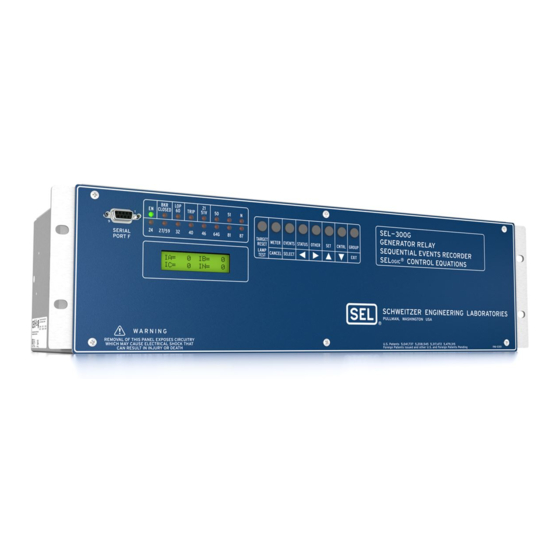
Schweitzer Engineering Laboratories SEL-300G Manuals
Manuals and User Guides for Schweitzer Engineering Laboratories SEL-300G. We have 3 Schweitzer Engineering Laboratories SEL-300G manuals available for free PDF download: Instruction Manual, Manual
Schweitzer Engineering Laboratories SEL-300G Instruction Manual (714 pages)
MULTIFUNCTION GENERATOR RELAY
Brand: Schweitzer Engineering Laboratories
|
Category: Relays
|
Size: 8 MB
Table of Contents
-
-
-
Welcome11
-
-
-
-
-
-
-
-
-
Relay Word Bits107
-
-
Recommendations116
-
-
Recommendations122
-
-
Pole Open Logic141
-
-
Demand Meter145
-
Introduction145
-
-
-
Feedback Control159
-
-
-
Power Loss162
-
Settings Change162
-
-
-
Input Functions170
-
-
Input IN101170
-
-
-
SER Triggering171
-
Alias Settings172
-
-
-
-
Introduction177
-
Relay Word Bits177
-
-
-
-
Unlatch Trip190
-
-
Close Logic197
-
Set Close198
-
Unlatch Close198
-
Settings Example199
-
Set Close199
-
Unlatch Close199
-
-
-
-
-
-
ON/OFF Switch218
-
-
-
-
-
-
Installation265
-
Relay Mounting265
-
-
Wiring Harness276
-
Chassis Ground279
-
Output Contacts279
-
Power Supply279
-
Serial Ports282
-
-
-
-
Introduction457
-
Breaker Monitor459
-
-
Via Serial Port465
-
Via Front Panel466
-
-
-
-
Via Front Panel467
-
Via Serial Port467
-
-
-
Energy Metering468
-
-
Introduction473
-
-
-
Commands485
-
Irig-B486
-
-
-
Access Level 0492
-
Access Level 2492
-
Access Level B492
-
-
Command Summary494
-
-
-
-
-
-
-
Currents529
-
Event Type529
-
Advertisement
Schweitzer Engineering Laboratories SEL-300G Instruction Manual (728 pages)
Multifunction Generator Relay
Brand: Schweitzer Engineering Laboratories
|
Category: Relays
|
Size: 6 MB
Table of Contents
-
-
-
Overview7
-
-
-
-
-
-
-
Relay Word30
-
Relay Word Bits105
-
Pole Open Logic136
-
-
-
-
Demand Meter141
-
Introduction141
-
-
-
SER Triggering164
-
Alias Settings165
-
-
-
Introduction171
-
Relay Word Bits172
-
Ogic177
-
Trip Logic182
-
Set Trip184
-
Unlatch Trip185
-
-
Close Logic190
-
-
-
-
-
Installation253
-
Relay Mounting253
-
Rack Mount253
-
Panel Mount253
-
-
-
Chassis Ground268
-
Power Supply268
-
Output Contacts268
-
-
-
-
Introduction329
-
-
Introduction334
-
-
-
Introduction346
-
Check List440
-
-
-
Figures
441-
Introduction443
-
Breaker Monitor445
-
Energy Metering453
-
-
-
Overview460
-
Introduction459
-
-
Introduction471
-
Irig-B472
-
-
-
-
Access Level 0478
-
Access Level 1478
-
Access Level B478
-
Access Level 2478
-
-
Command Summary480
-
-
-
Introduction519
-
-
-
-
-
Introduction561
-
-
Schweitzer Engineering Laboratories SEL-300G Manual (21 pages)
Generator Relay
Brand: Schweitzer Engineering Laboratories
|
Category: Relays
|
Size: 1 MB
Table of Contents
Advertisement
Advertisement
Related Products
- Schweitzer Engineering Laboratories SEL-321-5
- Schweitzer Engineering Laboratories SEL-321-2
- Schweitzer Engineering Laboratories SEL-321-3
- Schweitzer Engineering Laboratories SEL-352-1
- Schweitzer Engineering Laboratories SEL-352-2
- Schweitzer Engineering Laboratories SEL-321-1
- Schweitzer Engineering Laboratories SEL-387-0
- Schweitzer Engineering Laboratories SEL-387-5
- Schweitzer Engineering Laboratories SEL-351-3
- Schweitzer Engineering Laboratories SEL-351-4


